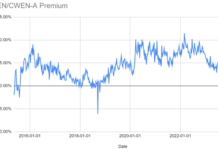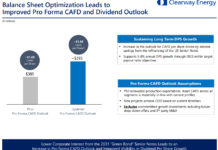Tom Konrad CFA
Disclosure: I have long positions in MCQPF and AQUNF.
Capstone Infrastructure Corporation (TSX:CSE, OTC:MCQPF) has been trading at a significant discount to its peers because of a power supply agreement which expires at the end of 2014. Capstone is seeking a new agreement with the Ontario Power Authority for its Cardinal gas cogeneration facility, a process which has taken much longer than management expected.
The cardinal Cardinal plant currently accounts for about a third of Capstone’s revenue and a quarter of earnings before interest, taxes, and depreciation (EBITDA), but two-thirds of distributible income. The high fraction of distributible income is because Cardinal’s debt has been paid down over the term of the expiring power supply agreement. This makes income from Cardinal (and the terms of a new power supply agreement) crucial to maintaining Capstone’s dividend.
 Capstone Infrastructure Corp.’s Gas Cogeneration facility in Cardinal, Ontario. |
In the company’s third quarter conference call, we learned a few tidbits which point to how and when the negotiations might be resolved.
Timing
In terms of timing, the Ontario Power Authority (OPA) is expected to release its new Long Term Energy Plan before the end of the year. It seems unlikely that the OPA would announce a new contract with Capstone before releasing the plan, so I expect that investors will have to wait until 2014 before we have any news on an actual contract.
The OPA did finalize a 20 year power supply agreement with TransAlta Corporation (TSX: TA, NYSE:TAC) for that company’s similar gas cogeneration facility in Ottawa. That facility’s previous agreement was expiring at the end of 2013. If Capstone’s negotiations follow a similar pattern, we would expect a new agreement for Cardinal in the middle of next year.
Likely Terms
TransAlta’s Ottawa power supply agreement is interesting in terms of its substance, in addition to its timing. Under that deal, the plant “the plant will become dispatchable. This will assist in reducing the incidents of surplus baseload generation in the market, while maintaining the ability of the system to reliably produce energy when it is needed.”
For similar reasons, the chance of Capstone and the OPA failing to come to any agreement seems minuscule. The Ontario government has committed to no new nuclear and an increasing dependence on renewables and efficiency. No new nuclear means lower overall supply, and more renewables means more variable power supplies, adding to the value of flexible plants such as Cardinal and Ottawa.
The Ottawa agreement provides for TransAltas’s plant to ramp up and down in response to the needs of Ontario’s power system. Dispatchable plants receive two types of revenues from the utility: payment for energy produced, and a capacity payment based on the plant’s ability to respond to system needs.
Cardinal is also a flexible facility, so it makes sense that Cardinal’s power supply agreement would also provide for the plant to become dispatchable. New capacity payments would go some way to making up for the lost revenue when Cardinal no longer operates as a baseload facility. In 2012 and 2013, Cardinal has been generating power nearly flat-out, running at a capacity factor equal to over 90% of its theoretical maximum.
The capacity factor of dispatchable facilities varies greatly. ”Peaker” plants tend to be relatively inefficient facilities with high operating costs which operate for only a few hours or days each year, when load is highest and all other facilities are already operating. More efficient cogeneration plants such as Cardinal and Ottawa are typically used to serve intermediate load. Such plants are dispatched whenever demand is high or moderate or when renewable power production is low. They are switched off at times of low demand or high production from renewables. Such plants usually operate at capacity factors between 30% and 70%, with more efficient, low-cost facilities operating at higher capacity factors. Cogeneration facilities tend to be among the most efficient.
Estimates
I modeled three scenarios for Capstone’s 2015 earnings under a new power supply agreement. For a worst case, I assumed that Cardinal would operate at a very low 15% capacity factor. My “expected” case would have Cardinal operating at a 55% capacity factor, and my “high” case would have it operating at a 65% capacity factor.
I then factored in moderate revenue and earnings growth from Capstone’s many development projects and capital investments to arrive at some rough estimates of Capstones future capacity to pay dividends. The company measures this capacity with “Adjusted Funds From Operations” or AFFO, and aims to pay out roughly 70% to 80% of AFFO as dividends.

Starting with Capstone’s recent share price of C$3.66, I assumed that management would maintain the current C$0.075 quarterly dividend through 2014, and pay out 80% of AFFO in 2015.
Although income and AFFO will drop with the new contract, the market is already pricing in a dividend decrease. Capstone currently trades at a dividend yield over 8%, while the closest comparable, Algonquin Power and Utilities (TSX:AQN, OTC:AQUNF,) yields 5.2%, so I assumed Capstone’s yield would fall to 6% in 2015, given the increased certainty embodied in a new contract.
In my expected scenario, this produced a C$4.70 stock price, while my worst case scenario had the stock fall to C$3.08, and the high case produced a stock price of C$5.06. The worst case scenario produced only a tiny net loss (less than 1%) over the next two years because of Capstone’s high dividend yield, while the Expected and High scenarios produced 45% and 55% two-year returns, respectively.
Conclusion
Ontario’s plans to meet its electricity needs without new nuclear power, and with the increasing use of wind, solar, and energy efficiency mean that the flexibility of Capstone’s Cardinal cogeneration power plant is increasingly valuable. The Ontario Power Authority is likely to reach a supply agreement with Capstone to provide for Cardinal to be operated as a dispatchable facility. Such an agreement is likely to be finalized well in advance of the expiration of Cardinal’s current agreement at the end of 2014.
Under such an agreement, Capstone’s income from Cardinal will almost certainly decline. However, the market currently seems to be pricing in a worst case scenario under which Cardinal operates only a fifth of the time. Under a more likely scenario, Capstone should be able to maintain its current C$0.30 annual dividend. If
that happens, the stock should appreciate for a two year total return of between 35% and 55%.
This article was first published on the author’s Forbes.com blog, Green Stocks on November 15th.
Disclosue: Long CSE, AQN,NPI,BEP,INE,RDZ
DISCLAIMER: Past performance is not a guarantee or a reliable indicator of future results. This article contains the current opinions of the author and such opinions are subject to change without notice. This article has been distributed for informational purposes only. Forecasts, estimates, and certain information contained herein should not be considered as investment advice or a recommendation of any particular security, strategy or investment product. Information contained herein has been obtained from sour









